Yikes, where to start?
If you’re thinking about torching the whole lawn with a flamethrower, a bulldozer, or 100 hungry goats — take a breath.
Whether you're a total beginner or a lawn care veteran who's losing the war with crabgrass, you're in the right place.
This guide is packed with tips tailored specifically for lawn care in Minnesota and Wisconsin — from when to fertilize to how to mow (spoiler: higher than you think), and what to do when your lawn starts turning weird shades of yellow.
Think of it as your seasonal roadmap to thicker, greener, more “stop-the-car-and-stare” kind of grass.
Hungry for the details? Let’s dig in.
Table of Contents
- Key Lawn Care Tasks by Season
- Why Healthy Soil is Crucial for Lawn Care in Minnesota & Wisconsin
- Fertilizing Tips for Wisconsin and Minnesota Lawns
- Weed Control Strategies for Lawns in WI & MN
- Preventing and Treating Lawn Disease
- How to Identify and Get Rid of Lawn Pests
- Aeration & Overseeding for Healthier Grass in MN & WI
- Lawn Mowing Tips
- How to Water Your Lawn in a Midwest Climate
- How a Lawn Care Service Can Help
- Choosing a Lawn Care Service in in Minneapolis or Eau Claire
Lawn Care in Minnesota & Wisconsin by Season
Your lawn doesn’t need the same care all year round, it’s a living thing that responds to the seasons just like you do. (Although it doesn’t put on flannel and order pumpkin spice everything.)
Here’s what your lawn needs in each season to thrive in our Wisconsin and Minnesota climate:
| Season | Key Tasks |
|---|---|
| Spring | - Apply pre-emergent weed control - First fertilizer by Memorial Day - Prevent grubs early - Mow (not too short) - Start up irrigation |
| Summer | - Mow high - Water deeply, not daily - Watch for lawn disease - Spot-treat weeds if needed |
| Fall | - Aerate and overseed - Apply fall fertilizer - Remove leaves - Spot-treat tough weeds |
| Winter | - Winterize irrigation - Avoid salt/snow piles on lawn - Plan spring services |
Why Healthy Soil is Crucial for Lawn Care in Minnesota & Wisconsin
When’s the last time you thought about your lawn’s soil? Bonus points for any answer other than “never.”
Since we have you here, it’s time to give some thought to improving your lawn soil.
Your soil isn’t what you see when you pull into your driveway every day, but it’s crucial to what you do want to see — a healthy, green, thick, thriving lawn.
If your soil is compacted, too sandy, full of clay, or has the wrong pH level, your lawn will struggle to get the food it needs to thrive. Think fluffy.
How to get great soil so you can brag about it at the next neighborhood block party? (“Dude! My soil is so fluffy!”)
Here’s a quick rundown on how to improve lawn soil:
How to Improve Lawn Soil? Aeration
for a compacted lawn.
When your soil becomes compacted, your lawn can't breathe. Its roots can't take in water or nutrients, which weakens your turf and opens the door for disease and weeds.
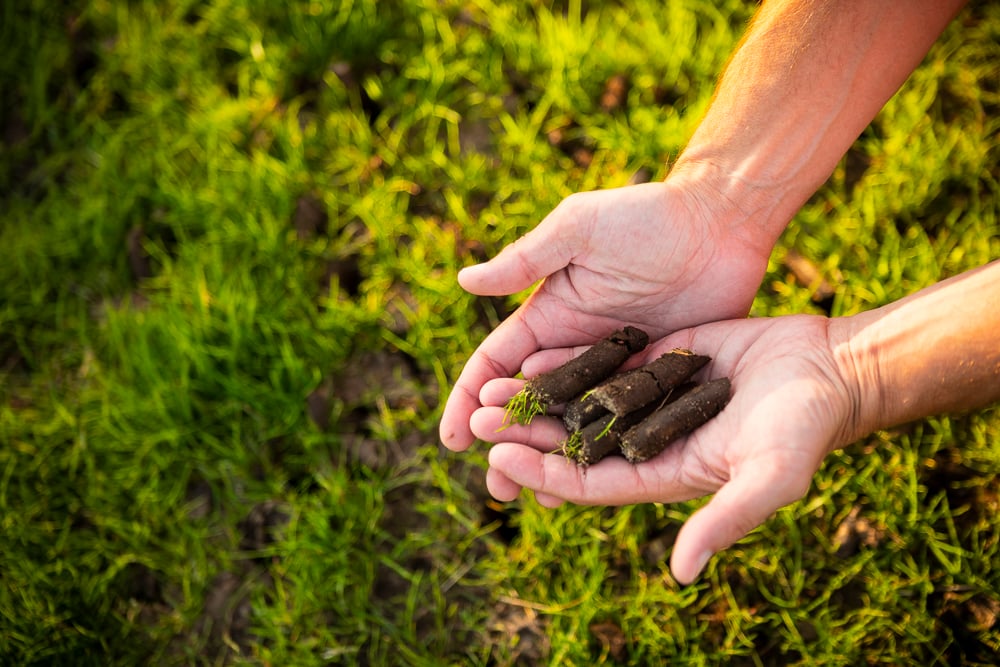 Aeration uses a cool machine to pull out tiny cores of soil from your lawn, allowing water and oxygen to get to the roots. Yay — fluffy soil!
Aeration uses a cool machine to pull out tiny cores of soil from your lawn, allowing water and oxygen to get to the roots. Yay — fluffy soil!
Improve Lawn Soil by Adding the Good Stuff
How to improve lawn soil? Add nutrients to give it a natural boost.
After aeration, when your lawn is filled with those little holes, top dress your lawn with compost.
And leave those grass clippings. Don’t bag them. They’ll break down into tasty nutritious bits that enrich the soil.
Get Your Lawn Soil pH Tested to Improve Lawn Soil
Two letters — one of them tiny — but they make a big impact.
A balanced lawn soil pH is key to a healthy, thriving lawn. Important nutrients for grass are available in soil when the pH is at the right level — not too acidic, not too alkaline.
If your lawn soil pH is off, your grass won’t get the nutrients it needs, no matter how much you fertilize.
It starts with lawn soil testing.
Here at RainMaster, we consider lawn soil pH so important for lawn care in Wisconsin and Minnesota that we include pH testing in all three levels of our lawn care programs. And we include pH balancer in our top two lawn care programs in Minneapolis and Eau Claire.
Healthy soil, healthy lawn.
Fertilizing Tips for Wisconsin and Minnesota Lawns
Next time you’re in the drive-through lane ordering a tasty double cheeseburger or rummaging through the cupboard for a bag of cheese puffs, think about your poor lawn.
 It can’t drive. Or munch cheese puffs.
It can’t drive. Or munch cheese puffs.
It’s starving out there, and it needs you to feed it. Fertilizer is your lawn’s food, and here’s what it wants you to know about fertilizing your lawn in Minnesota or Wisconsin:
Liquid or Granular?
Liquid fertilizer is, well, liquid. It comes in a concentrated form and is mixed with water to create a solution of nutrients sprayed on your lawn.
Granular fertilizer is solid pellets of product spread over your lawn then watered into the soil.
The basic nutrients in liquid lawn fertilizer are the same as in granular fertilizer, but they work a bit differently.
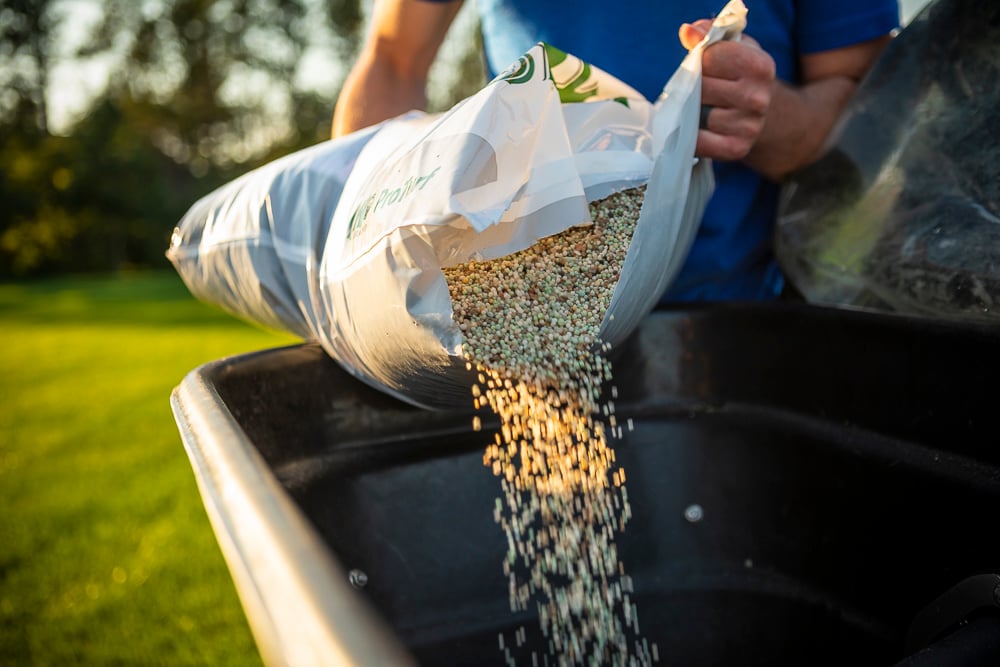 Liquid fertilizer delivers a quick dose of nutrients, while granular fertilizer offers a slow release of food for your lawn over time.
Liquid fertilizer delivers a quick dose of nutrients, while granular fertilizer offers a slow release of food for your lawn over time.
Always opt for granular lawn fertilizer for the best lawn care in Minnesota and Wisconsin. Yes, it costs more, but it breaks down slowly, giving you consistent benefits from fertilization.
Look for blends that also contain organic nutrients, which give your lawn that beautiful, deep green color and help your soil.
You’ll get premium professional-grade formulations of granular fertilizer from RainMaster. Not every lawn fertilizer service offers this.
When to Fertilize Your Lawn in Wisconsin or Minnesota
The first round of fertilizer and weed control should be done by Memorial Day. Three more applications should happen throughout the summer.
Don’t get so distracted by football and pumpkin spice lattes that you forget about fall fertilizing. That last boost of the year gives your lawn’s roots nutrients to grow nice and deep now, with some leftover for a healthy start — and greener grass — next spring.
But Whoa — Not Too Much
You wouldn’t eat an entire pizza yourself, right? (If you would, we’re only slightly judging.)
Too much food for your lawn isn’t great, either.
Too much fertilizer adds too much nitrogen and salt to the soil. It’s called fertilizer “burn,” and can actually kill your lawn.
So, follow the proper lawn fertilizer schedule and the product directions.
Better yet, hire experts in Wisconsin or Minnesota lawn care to fertilize your lawn for you.
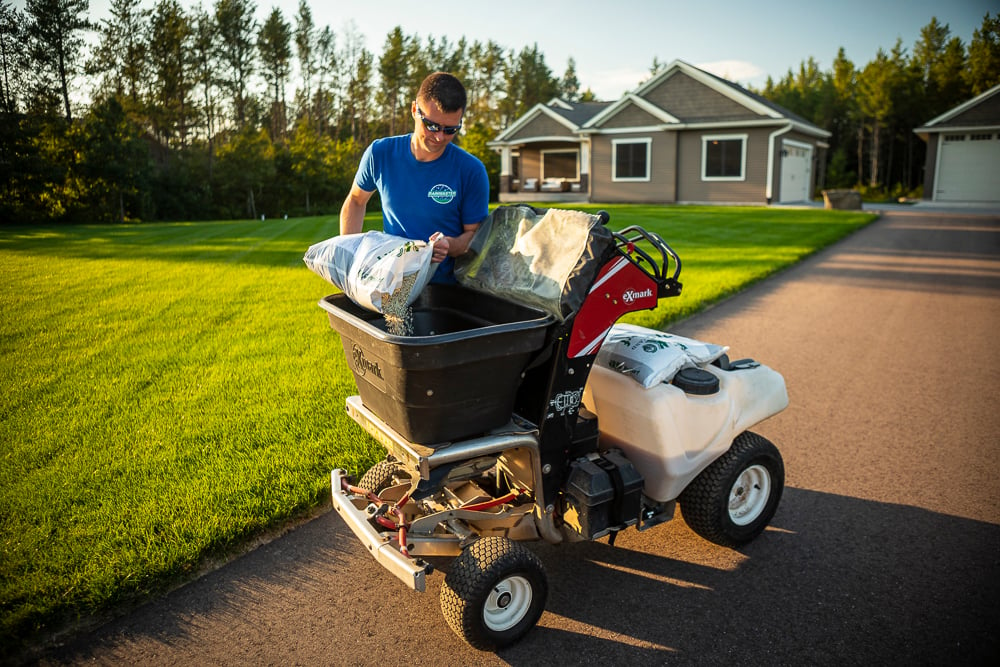 A professional lawn fertilizer service knows exactly how often to fertilize your lawn, what type to use, and they have the skills and knowledge to know what else your lawn needs to thrive.
A professional lawn fertilizer service knows exactly how often to fertilize your lawn, what type to use, and they have the skills and knowledge to know what else your lawn needs to thrive.
Weed Control Strategies for Lawns in WI & MN
If you just scrolled down directly to this section on how to get rid of weeds, you’re not alone. Everybody hates weeds.
If only you could scroll down through actual weeds and just hit delete, right?
Click! Bye, dandelions. Click! So long, sedge.
Let’s pause for a sec to ponder how awesome that would be. Sigh.
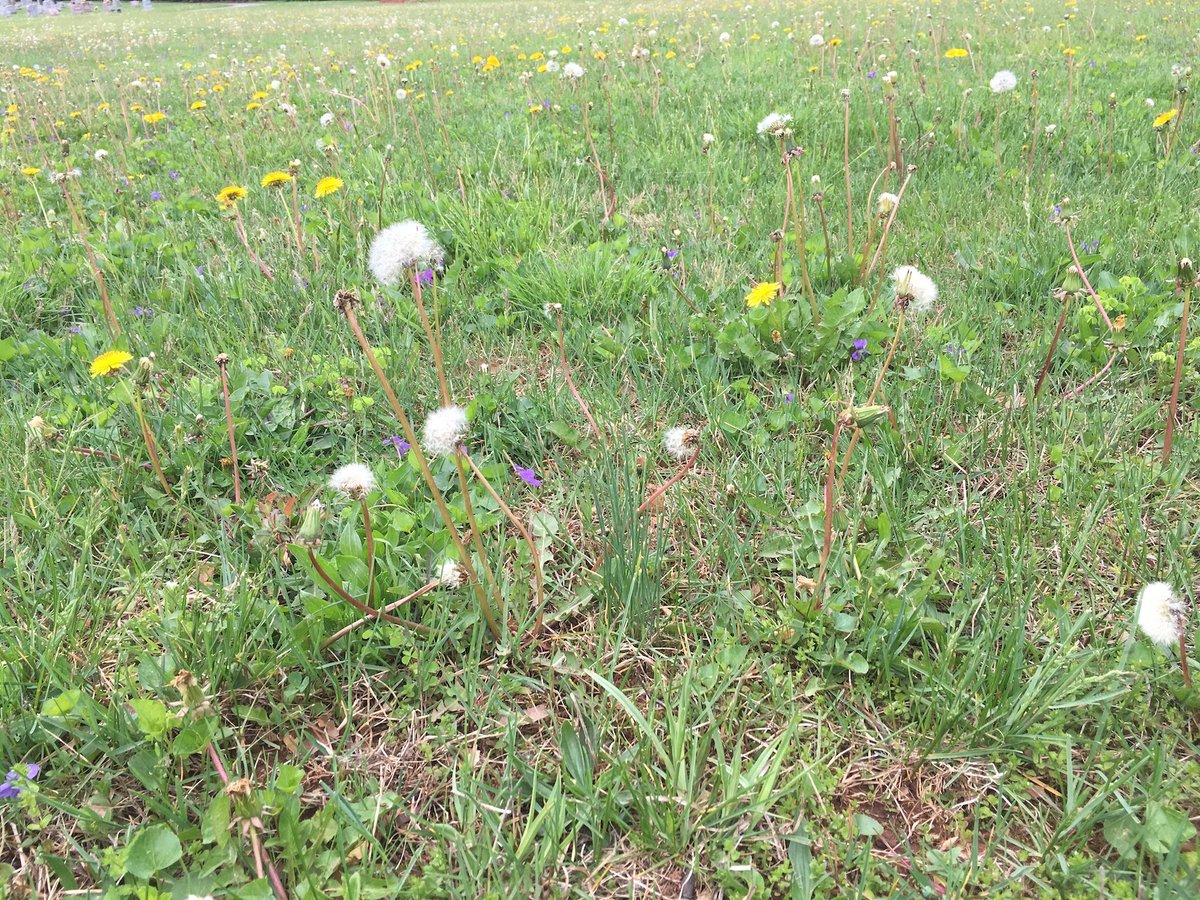 Sadly, there’s no one solution to battling Minnesota and Wisconsin lawn weeds. There are different types of lawn weeds, and the plan of attack depends on which weed you’re battling.
Sadly, there’s no one solution to battling Minnesota and Wisconsin lawn weeds. There are different types of lawn weeds, and the plan of attack depends on which weed you’re battling.
For crabgrass, pre-emergent is crucial — targeting the seeds as they germinate and take root in the soil. If you wait until crabgrass shows up, you’ll have a much tougher time getting rid of it.
Canada Thistle needs lawn weed control products to kill it, especially in spring and fall, before it can flower and seed.
We target dandelions with a specialty “weed shield” herbicide designed to reduce the number of dandelions that emerge. If any sneak through, we can treat them any time of year with a broadleaf herbicide.
Creeping Charlie is really tenacious. Using a professional-grade, specialty weed killer in the fall will go a long way to combat this weed. Your typical home improvement store weed control won’t do the job.
Lawn weed control isn’t a one-time thing. It’s a continuous process.
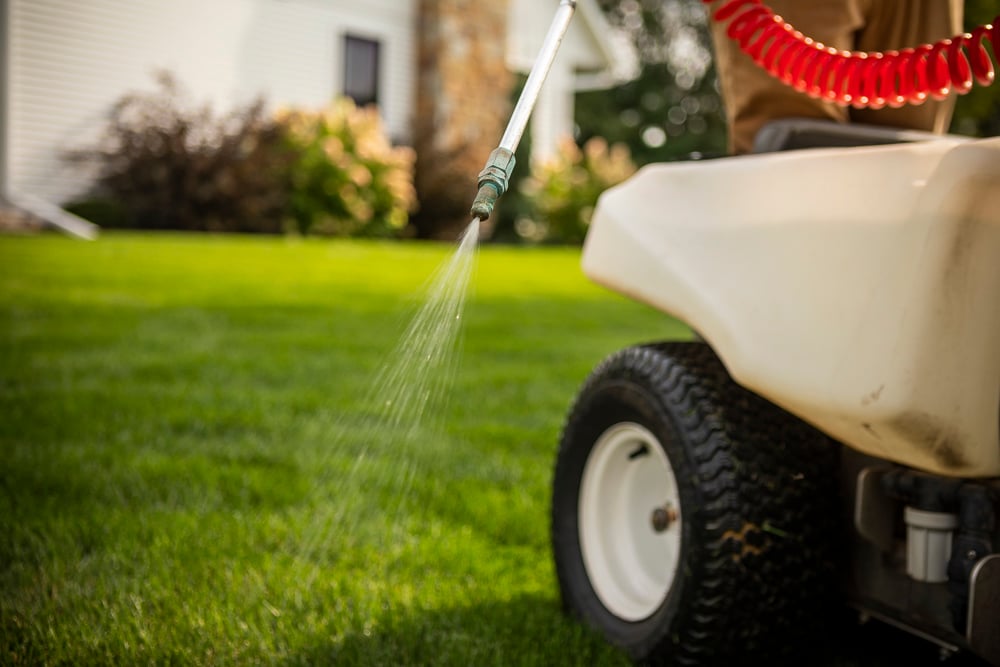 Different common lawn weeds in our area are active at different times of year. Many of the peskiest spring weeds actually germinate in the fall.
Different common lawn weeds in our area are active at different times of year. Many of the peskiest spring weeds actually germinate in the fall.
And some products work based on temperature, which means we may switch products as needed, based on the weather.
There’s a lot more involved in lawn care in Wisconsin and Minnesota than just applying products on your lawn.
The main thing to know about lawn weeds is it’s easier to prevent them than to get rid of them. And a thick, healthy lawn is the best way to prevent weeds.
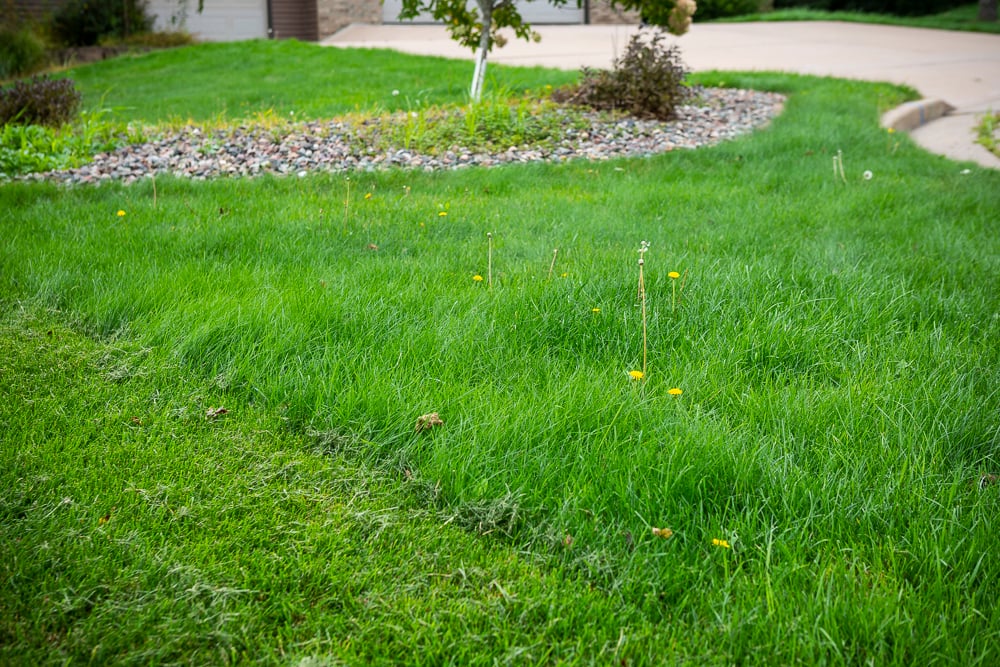 How to prevent weeds?
How to prevent weeds?
- Mow high. Taller grass helps a lawn grow thicker.
- Water properly. A lawn that’s too wet or too dry encourages weeds.
- Get a plan. Invest in a complete, proactive lawn care program that includes both weed preventative and curative treatments from early spring to late fall.
Preventing and Treating Lawn Diseases
If you head outside, take one look at your lawn and say, “Ewwww, gross!” you might have a lawn fungus. (Or your neighbor might be mowing your grass in his Speedo again.)
There are several different lawn diseases in Wisconsin and Minnesota, and none of them are cute.
Lawn fungus often thrives in the high temperatures and high humidity of summer. 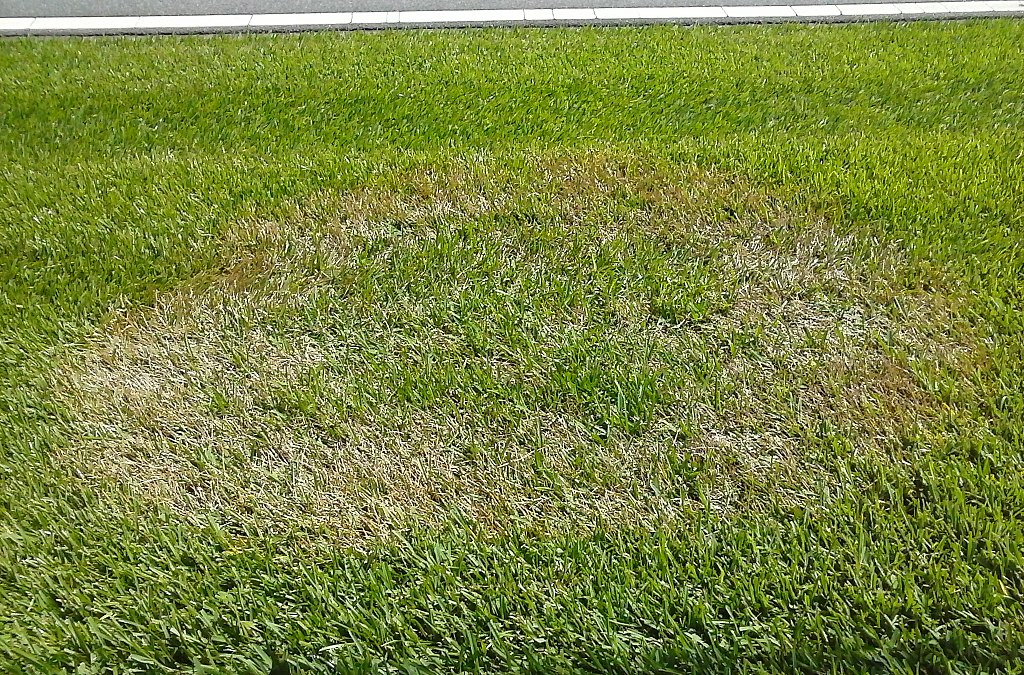
What the fungus?! What are these icky lawn diseases?
- Red Thread actually looks like red threads in your lawn.
- Dollar Spot causes bleached patches ranging from a few inches to a foot in diameter.
- Necrotic ring spot creates circular straw-colored patches usually less than 12 inches across.
- Ascochyta Leaf Blight causes large irregular patches of turf to quickly turn straw-brown in color and appear dead.
- Brown Patch appears as irregular circular patches in the lawn that are brownish yellow in color and range from six inches to several feet in diameter.
None of this sounds good, right?
How to Get Rid of Lawn Disease?
Good news: Lawn fungus often clears up itself if you’re patient. And the grass typically comes back on its own after the fungus disappears.
Bonus good news? You can prevent lawn disease in the first place with proper Wisconsin and Minnesota lawn care.
Here’s how:
- Fertilize your lawn well in the fall and spring so your lawn is healthy and has a better chance of surviving lawn fungus.
- Aeration. You want to reduce compaction and improve your lawn’s drainage.
- Don’t water too often — you don’t want your lawn to be too wet.
- Keep your grass height between 3 and 4 inches and avoid mowing
during wet weather. - Water early in the day, before sunrise, so your lawn has time to fully dry before evening.
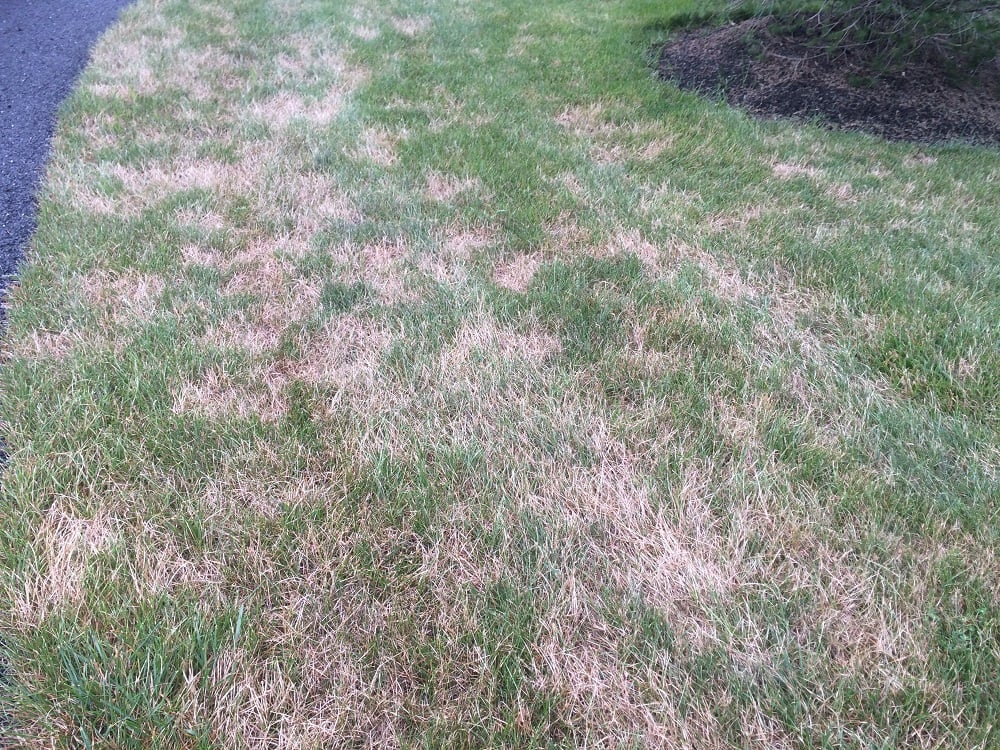 How to Identify and Get Rid of Lawn Pests
How to Identify and Get Rid of Lawn Pests
When it comes to pesky lawn pests, there are a few contenders.
That squirrel who keeps digging up your tulip bulbs and planting them randomly in your lawn to munch on later.
The disgusting digging mole who thinks your yard is an Airbnb.
But the king of pests is the grub. He’s such lawn pest royalty, he could wear a crown. Except he’s so slimy, it would keep sliding off.
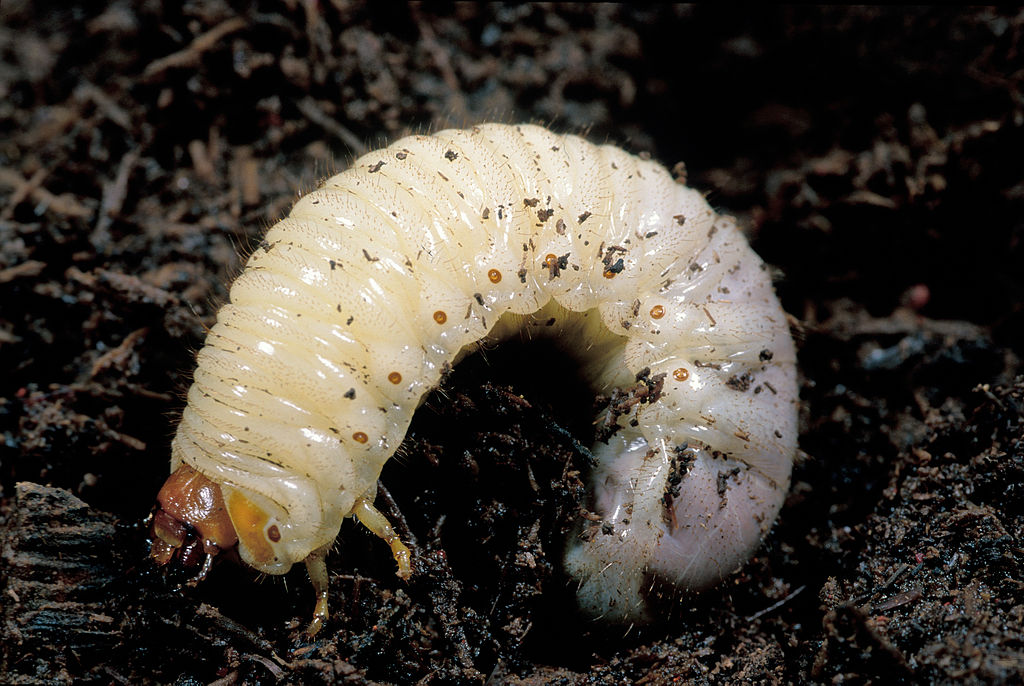 Grubs are the larvae of Japanese beetles, June beetles, chafers, and other beetles. And these larvae are super hungry.
Grubs are the larvae of Japanese beetles, June beetles, chafers, and other beetles. And these larvae are super hungry.
These white, C-shaped lawn grubs have soft, squishy bodies with legs near their head. They feed on grass roots and organic matter in the soil, causing sections of grass in the lawn to die.
And they make their food disappear faster than your kids pounce on the last brownie you thought you hid for later.
They can destroy your lawn with dastardly lawn insect damage in a matter of days.
How to Get Rid of Lawn Pests?
The key to grub control is to kill them before they hatch and begin to cause insect damage to your lawn.
Grub prevention is a key part of good lawn care in Minnesota and Wisconsin.
At RainMaster, we apply Grub Guard right away in the spring during our first visit.
Then, you’re all set. Our grub control lasts throughout the entire growing season.
Not all grub control lasts that long. Some products are weakened by the time a second wave of hungry grubs occurs in the fall.
Grub Guard is like getting insurance. You don’t know for sure you’ll get grubs. But better to keep them away with lawn insect control than risk your beautiful lawn.
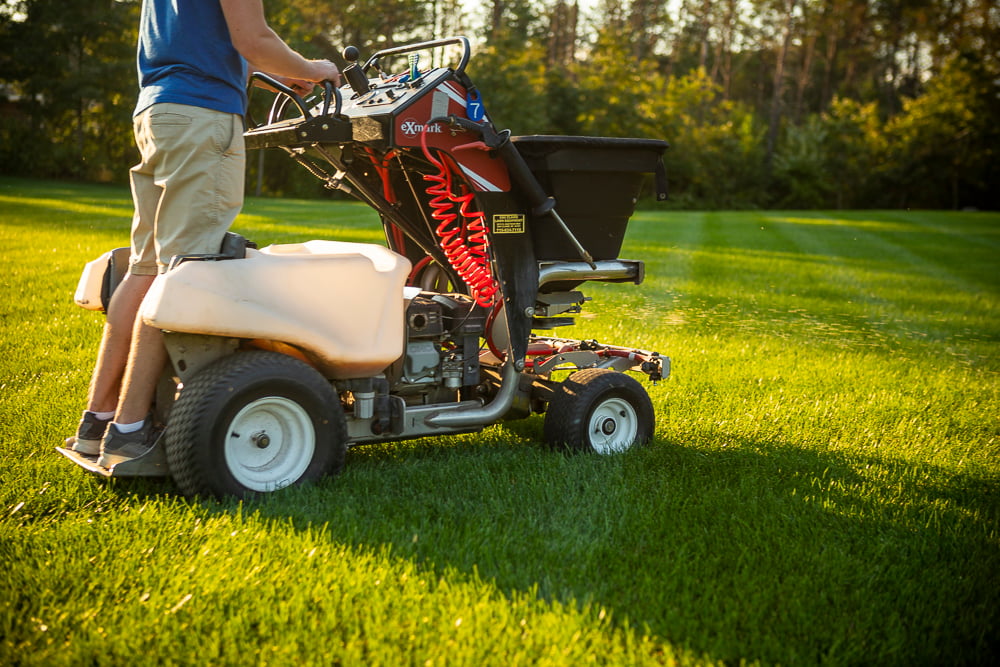 Bonus: When we apply Grub Guard to your lawn, it won’t kill bees like the cheaper products most other companies use that provide Wisconsin and Minnesota lawn care.
Bonus: When we apply Grub Guard to your lawn, it won’t kill bees like the cheaper products most other companies use that provide Wisconsin and Minnesota lawn care.
Aeration & Overseeding for Healthier Grass in MN & WI
Sometimes two things just go together, like grilled cheese and tomato soup. Or soft green grass and bare feet.
That’s how it is with lawn aeration and overseeding.
Why do these best lawn care pals go together so well?
Here’s why it makes perfect sense.
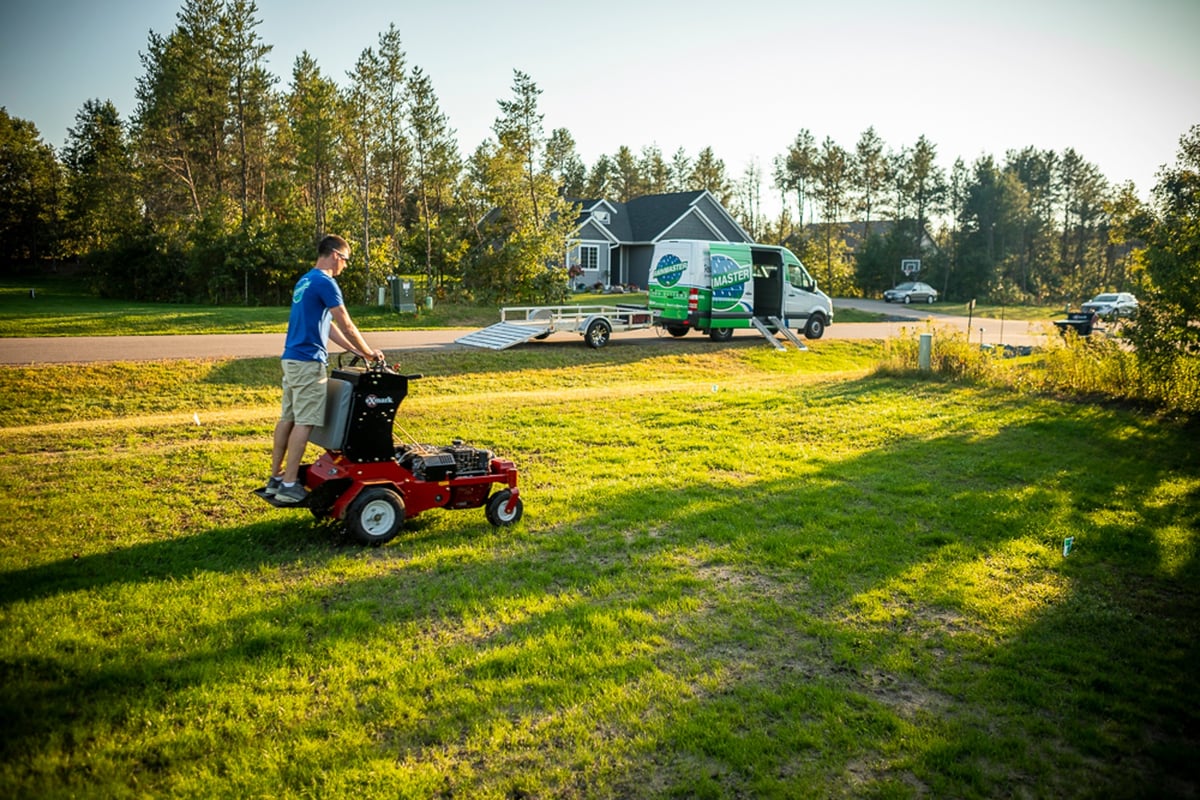 Aeration uses a machine to pull out tiny cores of soil from your lawn, allowing water and oxygen to get to the roots. It loosens up hard, compacted soil, so your lawn can breathe.
Aeration uses a machine to pull out tiny cores of soil from your lawn, allowing water and oxygen to get to the roots. It loosens up hard, compacted soil, so your lawn can breathe.
Now that your lawn is filled with tiny holes, what’s an obvious next step? Grass seed! It can snuggle right into those holes for great great seed to soil contact.
Lawn Aeration Benefits
Aeration leads to healthier roots. Healthier roots make for a healthier, thicker lawn, better able to resist pests and diseases and tolerate summer’s heat and drought.
Lawn aeration also helps break down thatch. Thatch is a layer of dead grass and stems that sits between the grass blades and the soil. When lawn aeration removes plugs from the thatch, it helps it decompose, so oxygen, nutrients, and moisture can get to the roots.
Overseeding a Lawn in Minnesota or Wisconsin: Why Do It?
If your lawn is thick and healthy, you might not need overseeding. But if there are thin spots, or you see fungus or disease, those are signs some fresh, quality seed can really do the trick.
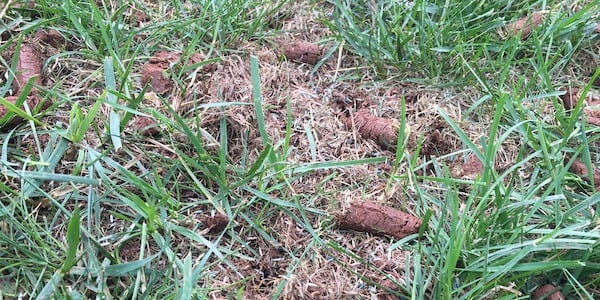 When to Aerate Your Lawn in Minnesota or Wisconsin
When to Aerate Your Lawn in Minnesota or Wisconsin
Fall is a great time to hire a lawn aeration service, especially if you’ll be following it up with seeding.
Warm soil and cool nights are perfect conditions for planting grass seed in Minnesota and Wisconsin.
Why Hire a Lawn Overseeding Service?
Maybe you’re the do-it-yourself type.
Can’t you just buy grass seed from the store?
Sure. But will you know you’re getting the right kind, designed for the conditions of your yard?
And will you actually know what you’re getting? Bargain seed from the big box store often has weed seed mixed in.
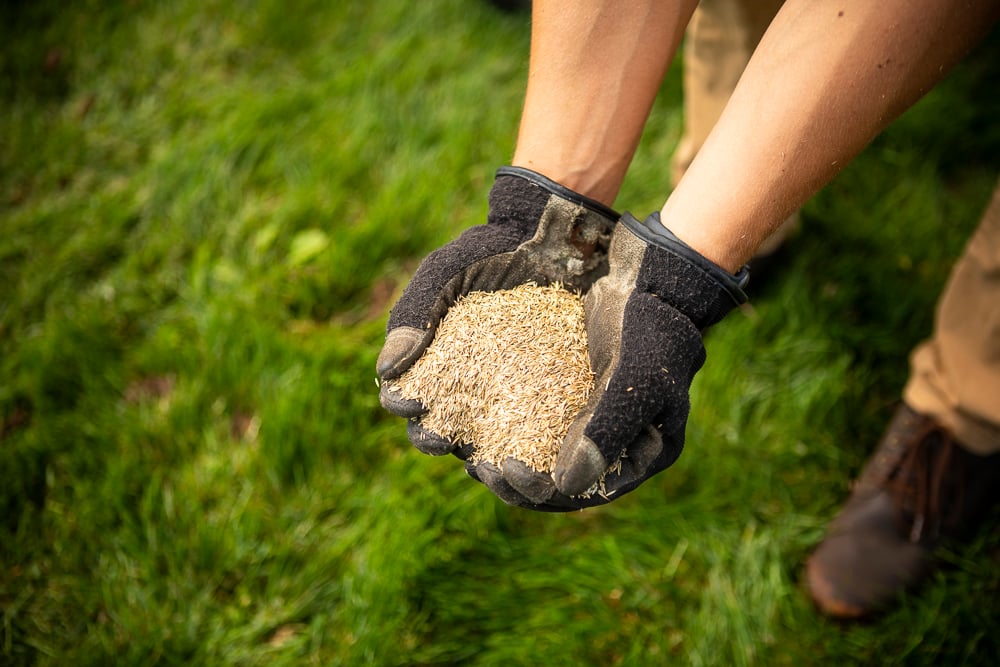 Let the pros cover your lawn with high quality, premium grass seed that’s a good match for your exact conditions, provides great color and resists diseases.
Let the pros cover your lawn with high quality, premium grass seed that’s a good match for your exact conditions, provides great color and resists diseases.
Lawn Mowing Tips
Tip number one: if you have a teenager at home, make them mow the lawn.
But if you’re the lucky mower, check out these lawn mowing tips:
Mow Tall
This isn’t about standing tall while you mow, although proper posture is always good.
Leave your grass a bit higher when you’re mowing the lawn. Mowing short actually hurts your grass.
When you mow, you’re removing a portion of the leaf surface that creates food through photosynthesis.
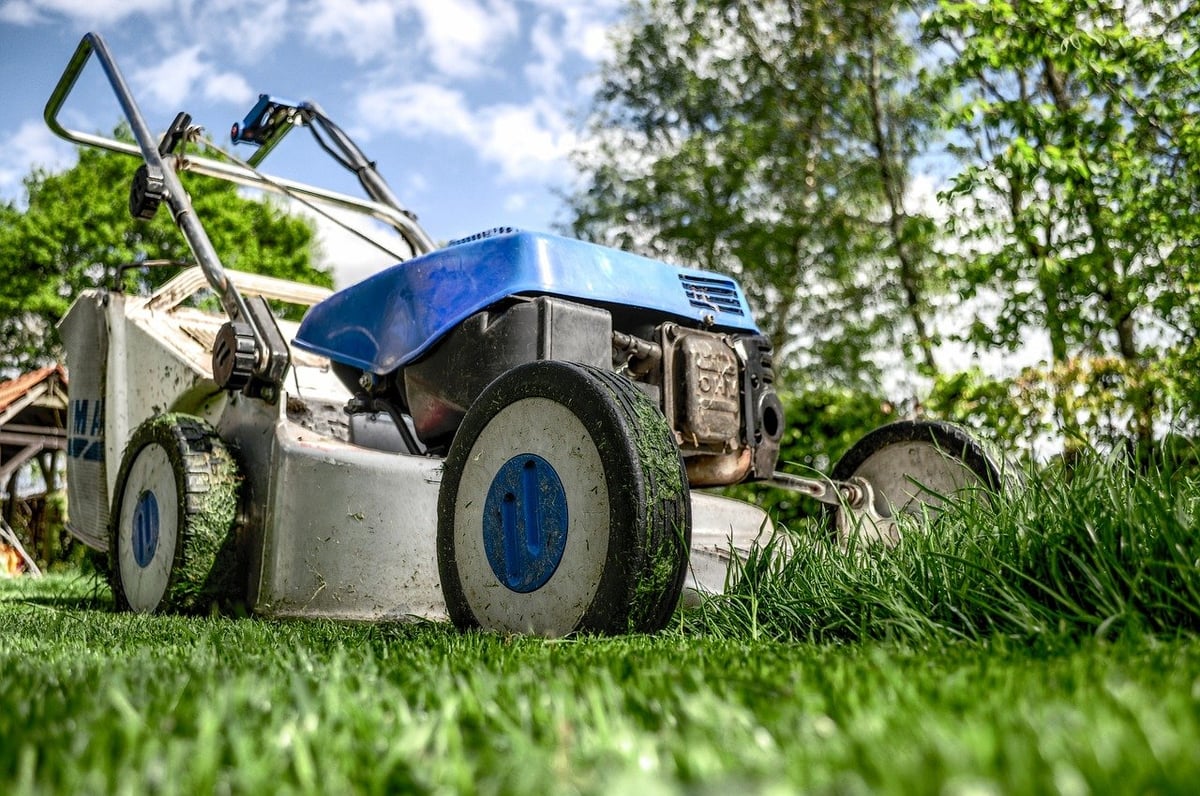 Take off too much, and you’re starving your grass. Bet you didn’t think about that as you’re charging across your lawn, right?
Take off too much, and you’re starving your grass. Bet you didn’t think about that as you’re charging across your lawn, right?
No more than a third of the grass blade should be removed during a single mowing. You might need to adjust your mower blade.
As summer progresses, you should keep raising your mower blade. Shoot for 3 inches in June, 3.5 to 4 inches in July and August.
Change Your Mowing Patterns
Calm down, you don’t need to cut fancy shapes into your lawn like stars or hearts or the silhouette of Elton John. But if you do, call us. We’d like to see that.
How to mow your lawn? Just change direction every time you mow. Over time, grass leans in the direction you mow. Change it up and it will help the grass grow straight up versus leaning in one direction.
Keep Your Mower Blade Sharp
This is one of those important lawn mowing tips that’s easy to forget.
A dull blade “rips” the top off a blade of grass, leaving a jagged edge that invites pests and disease.
A sharp blade makes a nice, clean cut, which helps the grass to heal faster and promotes photosynthesis — which makes it green. Which makes you happy.
How to Water Your Lawn in a Midwest Climate
If you’re standing on the porch with a garden hose and spraying your lawn until the microwave beeps and your pizza rolls are done, you’re doing it wrong.
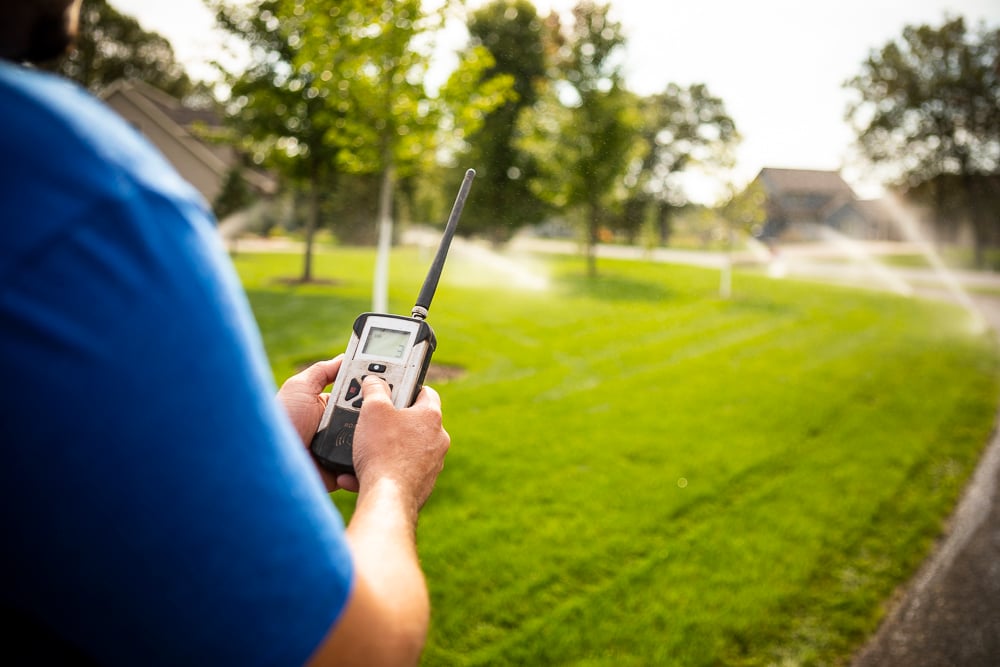 There’s a bit more to watering your lawn. Let’s get right to it so you can get back to your snack.
There’s a bit more to watering your lawn. Let’s get right to it so you can get back to your snack.
How Often to Water Your Lawn?
It’s easy to get carried away with watering your lawn, and actually water it too often. It doesn’t need water every day.
Water deeper, longer, and not as often for the best lawn care in Wisconsin and Minnesota. That encourages deeper, stronger roots, which means greener, healthier grass.
Watering your lawn too often encourages roots to hang out near the surface. Why should they head deeper in the soil to search for water when you’re serving it up so readily every day?
When to Water Your Lawn?
Wrap up your watering as close to sunrise as possible. If sunrise is at 6 a.m., you should be done watering at 6.
Why?
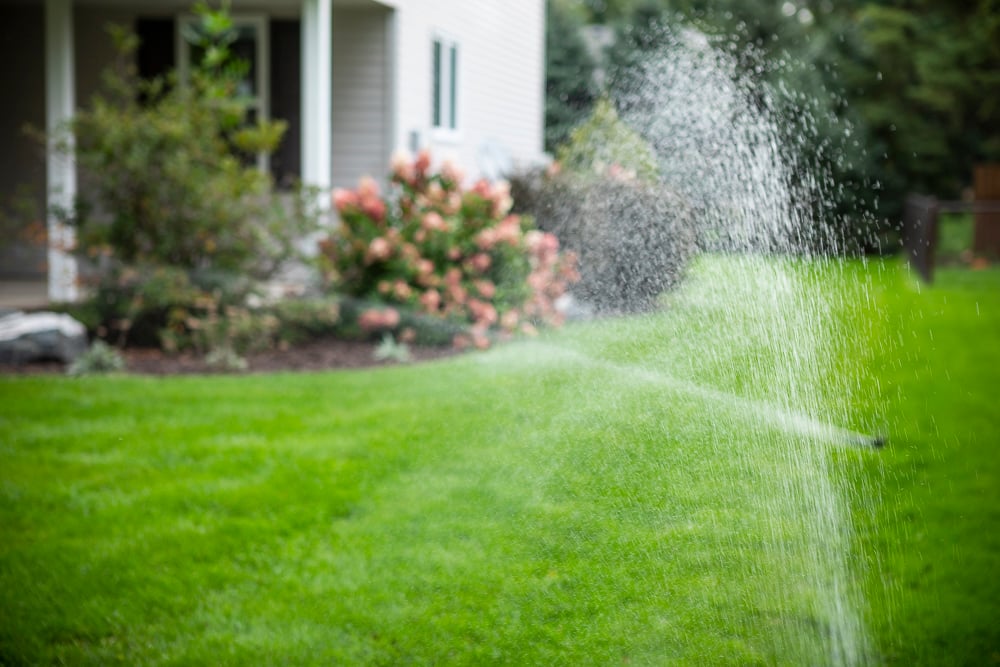 Wind typically picks up as the day goes on. You don’t want your precious water droplets to blow away.
Wind typically picks up as the day goes on. You don’t want your precious water droplets to blow away.
Also, the sun will cause your water to evaporate before it can soak into your soil.
How Long to Water Your Lawn?
This one is trickier. You might need to re-heat those pizza rolls.
The thing is, everybody’s yard is different. There are no universal rules for watering your lawn.
Your goal should be an inch of water per week, and that includes any rain that falls. But lots of different factors affect how long you should actually water your lawn.
If your soil is clay, you’ll water longer than if your soil is sand.
Are you on a slope? In the shade? What variety of grass do you have? What type of soil? What kind of irrigation heads?
 It’s kind of confusing. Your best bet? Hire a skilled and knowledgeable irrigation company to help you assess your particular lawn and create an irrigation plan perfect for your lawn.
It’s kind of confusing. Your best bet? Hire a skilled and knowledgeable irrigation company to help you assess your particular lawn and create an irrigation plan perfect for your lawn.
How a Lawn Care Service Can Help
If you’ve stuck with us this long, you’ve already read quite a few words.
Let’s keep this easy. How can a lawn care service help? One word: Results.
That’s really all you want, right?
If you’ve been dealing with the hassle and confusion of DIY lawn care,
you’ve probably already figured out that DIY products won’t get you that thick, healthy lawn you crave.
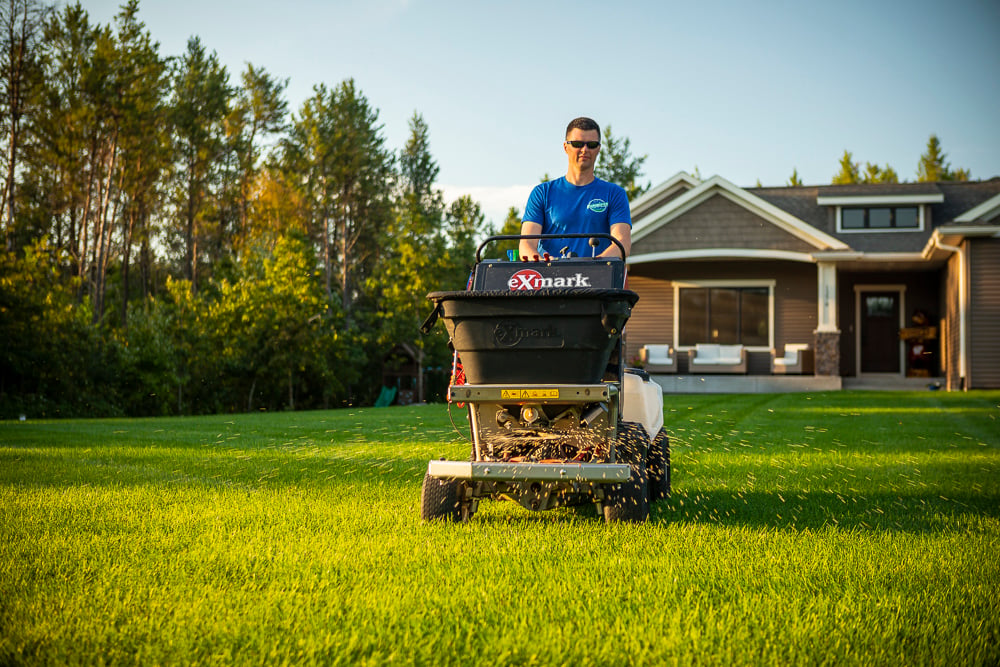 Why? What’s the main difference with DIY lawn care vs hiring a lawn care service?
Why? What’s the main difference with DIY lawn care vs hiring a lawn care service?
- Bargain seed from the big box store often has weed seed mixed in.
- All fertilizer isn’t the same. RainMaster uses premium professional-grade formulations of granular fertilizer, which is more effective than products you can buy at the store. It breaks down slowly, giving you consistent benefits from fertilization.
- Not every weed-killing product kills all weeds. And some weeds are so tough, they just laugh at those DIY products.
You can’t just grab a bottle or bag from the store shelf and expect it to work as well as the pro products lawn care services use.
Also, don’t you have better things to do? (Please say yes. We don’t want to have to worry about you.)
Hire a Wisconsin or Minnesota lawn care service, and you can ditch all the bags piled up in your garage, all the dates to keep track of, all the equipment to maintain that you’ve stubbed your toe on about 50 times.
Do yourself a favor and trust your lawn care to us. No equipment to maintain. No messy bags of fertilizer stacked in your garage, taking up space, spilling all over the place.
What services do lawn care companies provide? Everything you need, start to finish. Plus, you’ll get expert eyes on your lawn.
 When our lawn care specialists are out there spreading seed, or applying fertilizer, or treating for weeds, we’re looking at your lawn’s total health. That means we catch things early — before they turn into worrisome and expensive problems.
When our lawn care specialists are out there spreading seed, or applying fertilizer, or treating for weeds, we’re looking at your lawn’s total health. That means we catch things early — before they turn into worrisome and expensive problems.
And that all leads to one more word: relax.
Choosing a Lawn Care Service in in Minneapolis or Eau Claire
Don’t choose a lawn care company because of the cute puppy logo on their trucks, or because they leave a sale flier on your porch every four days.
There’s more to finding the best lawn care in Wisconsin or Minnesota than that.
For one thing, don’t assume everybody is offering the same services. They aren’t.
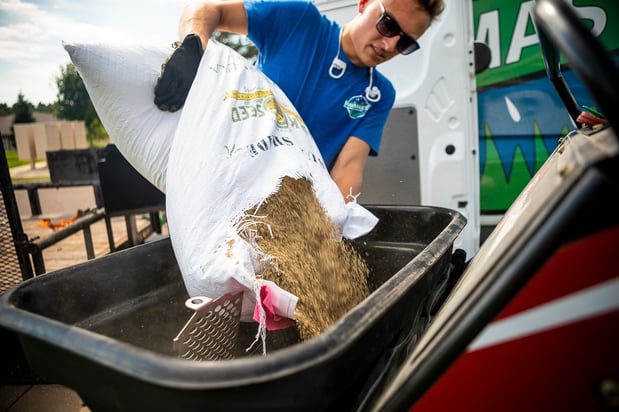 One lawn care service might offer fewer visits than a competitor. Another might offer a couple more visits, which sounds good, but they might be applying half the amount of product as the other guys.
One lawn care service might offer fewer visits than a competitor. Another might offer a couple more visits, which sounds good, but they might be applying half the amount of product as the other guys.
Not all Wisconsin and Minnesota lawn care companies invest in quality products that really improve the health of your lawn. Many don’t really focus on your lawn’s health. They’re concerned with covering up problems. This could cost you time and money down the road when your lawn has serious health issues.
This is why it feels so frustrating when you try to compare lawn care services. Make it easier by asking some key questions.
Do they know what the heck they’re doing out there? Will they show up? Will they answer the phone? Will your lawn look better and be healthier after they give it some expert care?
 If they suddenly gulp and run away, that’s a bad sign. A great lawn
If they suddenly gulp and run away, that’s a bad sign. A great lawn
care company in Minneapolis, MN or Eau Claire, WI should give you lots of good reasons to hire them, including that they offer skilled, efficient lawn care that will improve your lawn and help it thrive, and friendly customer service that takes away the stress and makes things easy.
Trust Your Lawn Care to RainMaster
Send back those 100 hungry goats and return the flamethrower to whatever suspicious character who lent it to you.
All you need for a healthy, green, thriving lawn is one smart choice: RainMaster.
Ready to upgrade your Wisconsin or Minnesota lawn care? Let’s create a customized plan based on your lawn’s needs and your goals.
Request a quote today, and finally enjoy your thick, green lawn — without the stress.
Image Source: Soil, Brown Patch, Grub, Mower




